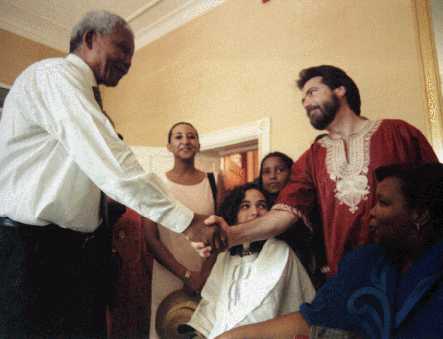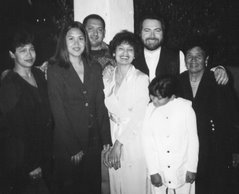 The San and Khoi gave refuge to Slaves
The San and Khoi gave refuge to SlavesMany runaway slaves, known as Drosters, were given refuge by San, Khoi, and Xhosa communities. Research shows that the San and Khoi had familial unions with the Xhosa, Europeans, Slaves and other African peoples, of which children were born, and thus have had an indelible affect on us all. Most particularly Coloured and Xhosa people have a strong relationship and shared bloodlines with the San and the Khoi which ought to be celebrated. Many Coloured people and Xhosa people are a strong part San and Khoi.
Heritage however, is not just about bloodlines, the past or ancient. It is also about the here and now. We cannot fully celebrate our Khoi and San heritage if we do not open our ears to the direct voice of the surviving San and Khoi people free of the array of interpreters. We also need to take cognisance of the painful history of the San and Khoi. History clearly demonstrates that the San and the Khoi were persecuted, exploited and raped by every other group in South Africa and this has had a devastating effect on the direct descendant clans who are part of our South African nation-in-the-making today. We need to set aside the mythologies that we labour under and the filters through which we see the San and Khoi. We need to recognise and respect the role of indigenous knowledge passed on by the San and Khoi. For those of us who have amongst our forbears, San and Khoi, though not part of the surviving clans, we ought to show pride of recognition.
Much has been written about the San and the Khoi (Quena) from the perspectives of archaeology, anthropology, ethnology and museology. In recent years some of these external perspectives have shifted in emphasis to the spirituality and shamanism of the San in particular.
The general tendency of all of these external approaches over the years, conservative and liberal, has been to create overlays on San and Khoi culture based on European understanding and processing of information. Regardless of intentions this has resulted in a tendency to impose interpretation, objectify, antiquate, ridicule, and at other times to romanticise, make exotic and create a curiosity out of this important South African ancestral heritage. The San and Khoi are artificially separated from other African peoples almost as if they were alien to the latter simply because of different histories and modes of living. Historically the halls of learning placed emphasis on the aggression shown to the San and Khoi by other African peoples, to bolster arguments of white possession of the land on the Southern tip of Africa. This also in a perverted manner allowed the papering over of a number of periods of wanton genocide by settler militias and the great scourge of smallpox introduced by European ships.
It is important that all South Africans, black and white, acknowledge all of our historic interactions with each other including roles in the violence meted out against the San and Khoi. We also need to recognise that there has been little mention or exploration of eras of successful coexistence and integration between the San, Khoi and other African peoples. For many South Africans the San and the Khoi should occupy pride of place as our most respected heritage line, and for this to occur, we all need to be able to reconnect.
In popular discourse the San are often thought of as a Cape-based people or amongst others they are thought of as having just been a people that lived in South Africa, Namibia and Botswana. However hundreds of sites of San habitation can be found as far as northern Angola in the West, Kenya in the East and throughout Southern Africa. The San or abaThwa and the Khoi or Quena, also referred to as Bushmen and Hottentots, have many wonderful clan names that most South Africans do not know. The names that we use are those given to the San and Khoi by others. There is so much to discover about this ancestral heritage that many of us share. There is also much pain that can be uncovered that continues to be visited upon the direct surviving descendant clans of the San and Khoi today. Spread over a number of Southern African countries the San component now number less than 100,000 people many of whom have emerged from a long state of 'living underground' within other communities.Perhaps the greatest thing that we can do is open our ears and hearts to listen to their tales.
There are those who question the 'purity' of such clans. To them I say that concepts of 'purity' are utter tripe. San group survival passed through many fires and assimilation into other groups was one of these fires, yet the identity was kept alive and it is the right of all descendants to express their identity preference and the cultural activity they hold dear. Some will express that San and Khoi identity is part of their identity and others will express that it is their whole identity. Those who have expressed themselves in the latter have continued to have a distinct experience which in modern times is still hallmarked by abuse and pain inflicted by others. Today these communities are standing up and saying that they refuse to accept continued victimisation nor to be defined simply in terms of victimisation or external curiosity.
The pain of the past and present calls on us all to give attention to the required healing, which could start by celebrating the ‘ties that bind us’. This means that we need to look at the San and Khoi through different eyes. Much of what we know, comes to us from European and academic voices, some opinionated and others facilitative and interpretative. The oral histories of black South Africa and most particularly of the direct descendants of the San and Khoi should also be heard as these will make a major impact on our perspectives of the past and present. There is now a new generation of literatures that amplifies these voices and the many untold stories which expose us to the links that we have with each other. More importantly is the voices of the San and Khoi clans who are still crying out to be heard.
What then are the Xhosa bonds with the San and Khoi?
The san and Khoi have a special place in Xhosa heritage for they are part San and Khoi themselves. The name Xhosa is the name ‘//kosa’ meaning ‘angry men’ given originally to a small Nguni clan by the San some time in the 1500s. From the lineage of Mnguni and Xhosa came King Cirha who was overthrown by Tshawe. In the time of King Tshawe a process was set in motion whereby the amaTshawe would spread the Xhosa kingdom by bringing San, Khoi and other independent Nguni clans under a loose confederal Tshawe authority.
In this process the clicks of the Khoi languages were introduced into the Xhosa language and many inter-marriages took place. The Xhosa word for the Christian God, uThixo is a Khoi word which originates from a folk hero of the Namaquas who was said to have extraordinary powers. Intermarriage and a sharing of cultures with the San and Khoi were widespread amongst the Xhosa with many Royals intermarrying. The Gonaqua, Damaqua and Hoengiqua Khoi were not displaced from their ancient homes but simply were incorporated into ‘Xhosadom’ with full rights. Together with the Xhosa, the Khoi and San fought colonial expansion during the frontier wars. Their efforts were joined by runaway slaves and even a few non-conformist European settlers who assimilated into Xhosa society.
History books were silent on the non-conformist Boers, Free Slaves and Khoi clans who fought on the side of the Xhosa during the Frontier Wars which raged for over a century.
Two of my favourite STRONG images of the KHOI or Quena





No comments:
Post a Comment